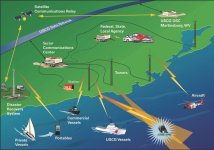tomherrick":xs1td0qk said:
Hey, Ken,
Yeah, it started with VHF but thanks to the folks here and on other forums the thread grew and I certainly am learning a lot - enough to cause more questions... Hopefully, others will as well.
In general I get that the tools you mentioned are different, but there seems - to this novice - to be some overlap in functionality with some of them. Are a VHF DSC and a PLB redundant in functionality? Are they both calling the same SAR units? Are they both calling different SAR units simultaneously for the same event if I push the "SOS" buttons on each device, causing more units to be deployed for a single event? Or, should one have both VHF DSC and a PLB to enhance the likelihood of the full cavalry in response?
Thanks,
Novice...
The PLB is an emergency locator beacon, which goes directly to a satellite. The encoded message (if the unit is registered with NOAA) is matched with the owner. A PLLB is issued to an individual, and can be used on a variety of boats, hiking , amping skiing, off roading etc. The satellites are all virtually in "view" (as long as not blocked in some very narrow canyons, or under a cave etc From the satellite

The phone numbers in the register are called and the nearest SAR unit (land or sea, anywhere in the World) is alerted. I have heard of on the water response as fast as 30 minutes. This is world wide, and there are a data base of emergency providers. As noted the main satellite signal is 406 MHz. There is a secondary beacon at 121.5, which is the aircraft rescue frequency. It used to be all air craft ere to monitor this band, but I believe that is no longer the case. the 121.5 mhm signal is used for honing into the location. The lat and long are also included with the beacon message. So the SAR has a very precise location--of where the initial signal originate from. Updates are available in real time via the SAR center.
An EPIRB is similar, has a battery life of at least 48 hrs vs the 24 hours for the PLB, and is assigned only to one vessel. It should not be moved from vessel to vessel, except as you step up into your life raft. Neither of these should be used for anything other than very serious emergencies.
The VHF DSC is on channel 70 on the VHF radio--it is basically dependent on line of sight and other vessels being close enough to get the digital signal. It is earth bound, and only usable on boats. The digital signal will push thru when voice may not. The Boat is assigned an MMSI number (Free with membership in Boat US, and some other agencies). The MMSI number must be programed into the radio DSC. The red button sets off the radio DSC. " The radio will continue to send the message until someone acknowledges it. This message is fast (only 1/3 of a second), accurate, complete and automatic. It will continue to broadcast even if the skipper is incapacitated."








